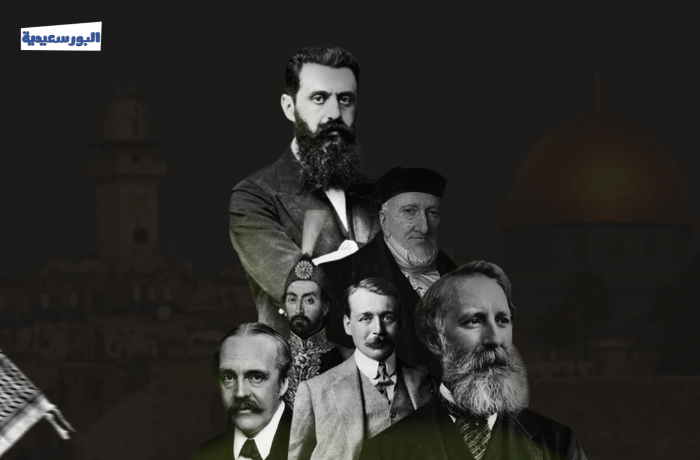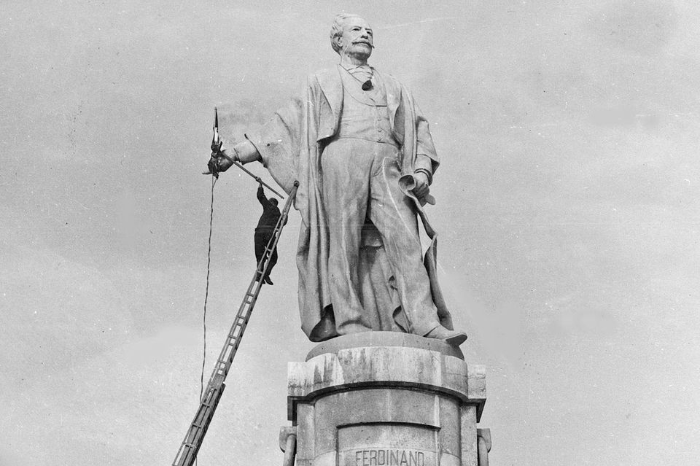By the 16th century, the Jews numbers in Palestine reached around five thousand people. In 1881, they reached 25 thousand, following the irregular migration from Europe as result of being persecuted there. A half a century before this, in 1837, Jews were not allowed to own lands in Palestine, as per the Ottoman Firman (royal decree); as Palestine was under the Ottoman rule at that time.
The late writer and scholar, Abdulwahab Al-Misiri, wrote in his Encyclopaedia of Jews and Judaism, and Zionism, that the first Jewish settlement in Palestine was founded by Moses Montefiore, a very wealthy British-Jewish who owned multiple banks; he visited the Ottoman Sultan Abdulmejid I, who granted him a Firman which enabled him the advantages of building and establishing the first settlement in Jerusalem, inhabiting in it the first group of European Ashkenazi immigrants.
Palestinian Forum for Israeli Studies points out that Montefiore bought the land from a Jewish Rabbi called Yehuda Halevi Margoza, head of the Jewish community in Jaffa at that time.
Montefiore settlement population, at the time of its establishment, was 1500 Jews, and by 1840 the numbers of immigrants increased reaching 10,000 Jews, then 15,000 in 1860, reaching to 22,000 in 1881. A year after, in 1882, groups of Russian immigrants started flowing into Palestine; despite the law issued by the Ottoman authorities limiting the migration process; the first group was estimated by two thousand Jewish immigrant.
In 1897, the cornerstone of the Occupant was laid; World Zionist Organisation was founded by Theodor Herzl, the Austro-Hungarian Jewish lawyer, journalist, and writer, who decided that Palestine is the homeland of the Jews, the thing that spiked the numbers of immigrants, as large numbers of organised Jewish immigrants came to live in the settlements with the aid of the Zionist organisation under British supervision. By 1900, the numbers of Jews in Palestine reached 55,000.
In 1916, Sir Mark Sykes, a member of the British House of Commons, and Consul François-Marie Picot concluded the “Anglo – French – Russian” agreement or “Sykes – Picot”, representing Britain and France in negotiations on dividing the Middle East before the defeat of the Ottoman Empire in World War I, so that Palestine would fall under the British mandate.
On 2nd November, 1917, the “Balfour Declaration” was issued, according to which Britain, through Lord Arthur James Balfour, the British Foreign Secretary, granted the Jews the right to establish a national homeland for themselves in Palestine. This promise was the actual real first step taken by the west on the road of establishing a Jewish entity on the land of Palestine; answering the calls of the global Zionism.
The Interactive Encyclopaedia of the Palestine Question, conceived by the Institute for Palestine Studies, as part of a joint project with the Palestinian Museum, mentioned that Balfour promise was written in the form of a short message from the minister to Lionel Walter de Rothschild, head of the Jewish community in Britain, after the consent of the British cabinet.
The promise/declaration was as follows: “His Majesty's Government view with favour the establishment in Palestine of a national home for the Jewish people, and will use their best endeavours to facilitate the achievement of this object, it being clearly understood that nothing shall be done which may prejudice the civil and religious rights of existing non-Jewish communities in Palestine, or the rights and political status enjoyed by Jews in any other country”.
The Encyclopaedia mentions that the British aimed at winning the American, German, and Russian Jews’ support of their military efforts, while enhancing and consolidating their claim over Palestine after the war, supporting their control over Egypt and Suez Canal as an international shipping lane.
Balfour declaration contradicts with the British promises to the Arabs, for after only a month from its issuance, the British forces invaded Palestine and took over Jerusalem in December 1917.
Things went downhill from there; in 1918, a military government ruled Palestine, a Jewish homeland there was promoted, even before Palestine falling officially under the British mandate. By 1920, Herbert Samuel, a member in the Zionist Organisation, became the first High Commissioner for Palestine.
Belfour Declaration revived the Jewish migration movement from Europe to Palestine, during the period between World War I (1914 – 1918) and World War II (1939 – 1945), at the time when Europe was witnessing a rise of the anti-Semitic national wave.
Palestinian lands were subjected to five consecutive waves of Jewish migration, starting from the later 19th century to World War II, according to the Palestinian News and Information Agency – WAFA.
A year before the Nakba (catastrophe) in Palestine, the United Nations voted - in accordance with Resolution No. 181 of 1947 – on the decision to partition Palestine into two states, one Arab and one Jewish, with Jerusalem placed under a special international regime.
Jewish leaders consented on the decision, while the Arabs rejected it, however it was never applied.
Britain used this decision as a pretext to end its mandate over Palestine in 1948, marking the declaration of the full control of the occupant entity over the country, this was followed by the process of expelling the Palestinian Arabs from their land. The Zionist movement exerted huge efforts to facilitate and intensify the Jewish migration to Palestine, then the 1948 war or what was known afterwards by Nakba erupted in an attempt to stop these efforts.
WAFA describes the Nakba as the biggest ethnic cleansing the 20th century has ever witnessed; more than 957 thousand Palestinians were forcefully displaced from their villages and cities under force of arms and threats by the Jewish gangs, sending them to the West Bank, Gaza, and neighbouring Arab countries, this was out of million and 400 thousand Palestinians who used to live in the historic Palestine in 1948, as Jews came seized their lands and stole their homes.
The Interactive Encyclopaedia of the Palestine Question says that expelling Palestinians from their lands started in 1947, as random terrorist attacks increased on villages, towns, and Arab cities launched by two Jewish organisations: “Haganah and Irgun”.
After 1948 Nakba, the gangs affiliated with the organisation controlled more than 85% of historic Palestine lands (27 thousand kilometres), putting their hands on the resources, meaning more than 75% of the country. They invaded and controlled 774 Palestinian village and city, totally demolishing 531 of them, obliterating their cultural and historical landmarks, subjecting the rest to the occupation entity and its laws.
The organisation’s members committed more than 70 massacre against Palestinians, whereas only 150 thousand Palestinians remained in the cities and villages on which the Israeli occupation state was established after the Nakba.
UNRWA records indicate that Palestinian refugee camps numbers at that time reached 58 camps, which were officially affiliated with the agency, distributed as follows: “10 camps in Jordan, 9 camps in Syria, 12 camps in Lebanon, 19 camps in the West Bank, and 8 camps in Gaza”.
On 5th June 1967, Six-Day War or Naksa (setback) took place, which the occupant entity waged against Egypt, Jordan, and Syria. The war ended with Israel occupying the West Bank, the east of Jerusalem, and Gaza, as a result of the Jordanian troops withdrawal and return to the east from the Jordan River.
The occupying Israeli forces withdrew from Gaza in 2005 enforcing a full siege upon it.
Since the occupation, around 600 thousand Zionist Jews live in around 140 settlements, whereas the rest of the international community sees them as illegal settlements as per the international law, however Israel disagrees.
The United Nations Security Council confirms that the settlements in this area are illegal, representing an “flagrant violation of international law”, the most recent of which was the council resolution No. 2334.
The International Court of Justice has acknowledged through its advisory opinion on the Separation Wall in 2004, that the occupant entity is an occupying force outside the division recommendation, saying that the political events which took place in the region; like including Jerusalem, the peace treaty between Israel and Jordan in 1994, doesn’t change the fact that Israel is an occupying force, and remains according to the international law as an occupying state.
Searching the international law texts, we’ll find that the initial internationally accepted legal framework for defining the meaning of occupation was in mentioned in the Hague Conventions (II) of 1899, in Articles 42 and 43, which are identical to Articles 42 and 43 of the Hague Conventions (IIII) of 1907, which stipulate: “Territory is considered occupied when it is actually placed under the authority of the hostile army. The occupation extends only to the territory where such authority has been established and can be exercised for the purpose of returning it to the state that exercised previous sovereignty”.
Hague Conventions focused on defining the obligations of the occupying entity towards the state that enjoyed sovereignty before the occupation, however the Geneva Convention, which consists of four international agreements, the first took place in 1864 and the last in 1949, shifted the focus to the obligations the occupying entity has towards the inhabitants of the occupied territories.
Universal Declaration of Human Rights, issued in 1948, stated, in Article 13, that “Everyone has the right to leave any country, including his own, and to return to his country”, the thing which was confirmed by Fourth Geneva Convention and Assembly Resolution issued in 11th December 1948, Article 11: “Refugees wishing to return to their homes and live at peace with their neighbours should be permitted to do so at the earliest practicable date and that compensation should be paid for the property of those choosing not to return and for loss of or damage to property which, under principles of international law or in equity, should be made good by the Governments or authorities responsible”.
The Articles that Israel obviously violated, issuing the Law of Return in 1950, stating that: “Every Jew has the right to come to this country as an Oleh (immigrant)”, and that they would carry immigrant visas.
In return for all of that, The Israeli Citizenship Law issued in 1952 stipulates that each Jew has the right to migrate to Israel and granted the Israeli ID once they enter the country, in addition to encouraging and organising the Jewish Immigration Agency, and taking care of all the immigrants’ affairs upon their arrival, the thing which encouraged more Jews to migrate to Palestine.







